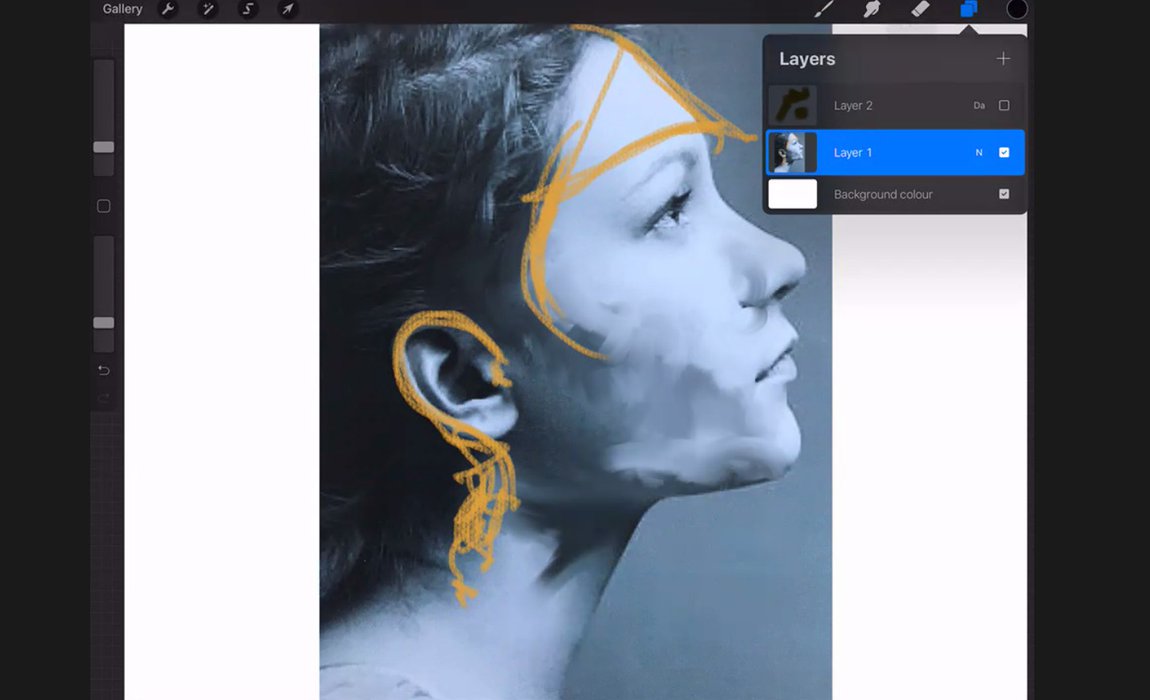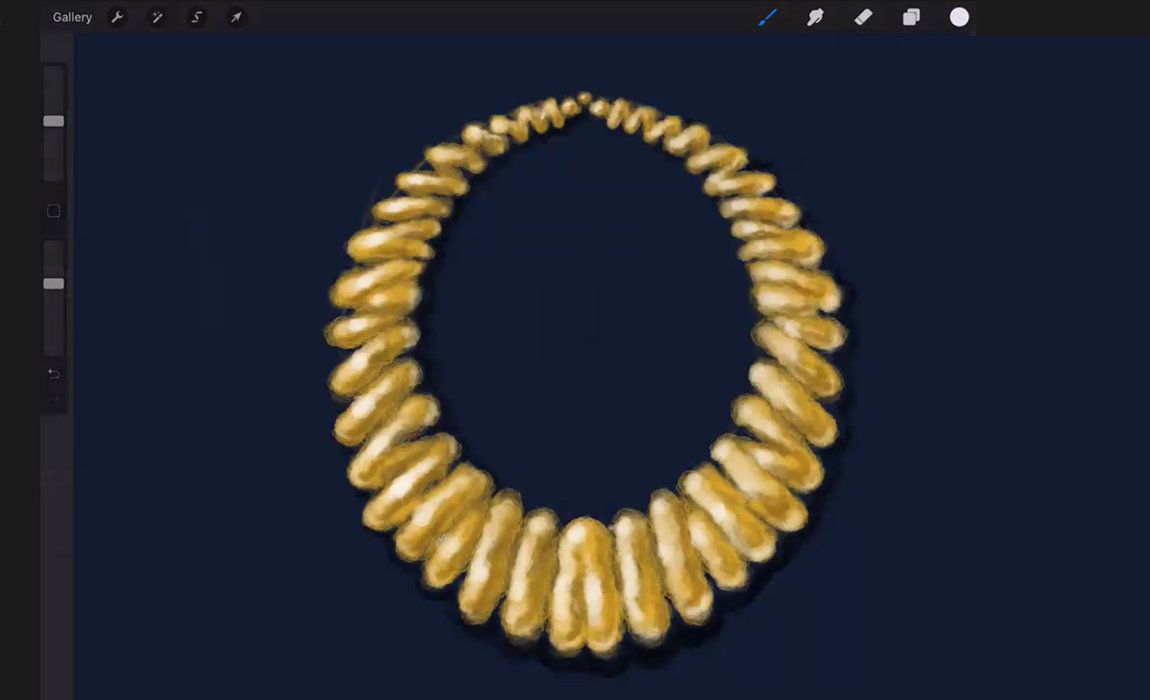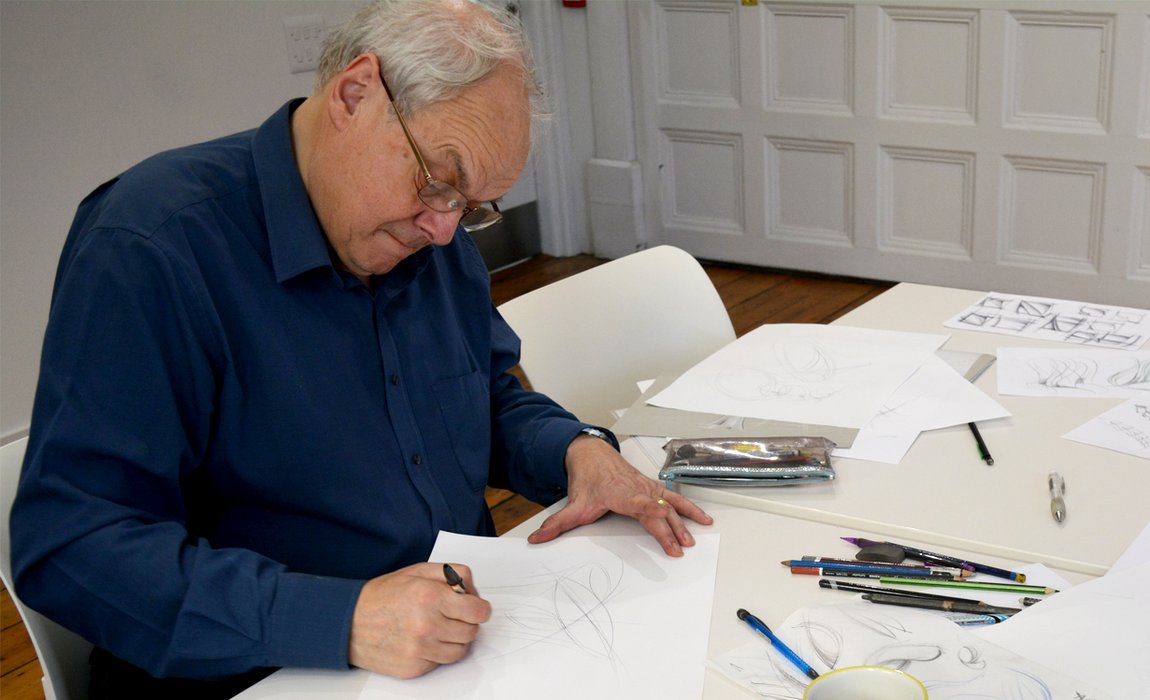The Potential of Digital Jewellery Design: An Interview with Mark Lewis
Drawing has long been central to the creative practice of Mark Lewis; a London-based jeweller, silversmith and artist, who is also the subject of our latest interview.
Describing the iPad as a ‘studio in a tablet’, Mark has led the way in translating traditional design and drawing skills to digital technology. With over 37 years’ teaching experience, he is dedicated to sharing the creative potential of the iPad with his fellow makers and artists, and currently oversees regular iPad drawing short courses at the Goldsmiths’ Centre.
Mark, you describe yourself as a jeweller, silversmith and freelance artist. Can you tell us more about your career and when you first picked up an iPad to sketch?
I started my career back in the 70s at the School of Jewellery in Birmingham. I’d had a desire to be a jeweller and silversmith even during my early school days. Once I was qualified, I got a job with a leading jewellery and silversmithing company in London, which was very useful for my professional and creative development. A couple of years later, I bravely decided to go freelance, and joined forces with a couple of my graduate friends to get started in a studio. That was a struggle at first, but I had some interesting work - primarily silversmithing, because that’s really what I specialise in, but also very diverse commissions and some antique restoration work.
Then when I decided to get married and suddenly had a mortgage, I realised that I needed a more regular income, so I took a full-time teaching job. At that time, I’d already been doing some part time teaching in adult education, but this was my introduction to further education. A few years later I taught at Sir John Cass’ Department of Art, Architecture and Design at London Metropolitan University for about seventeen years. Then I got a job at the School of Jewellery in Birmingham, so I was back at my old school, but on the other side of the fence. It was during that time that I also started working with the Goldsmiths’ Centre, and I have been with the Centre since the year it opened, in addition to a few other part-time teaching jobs, including University of Creative Arts and other institutions.
Other aspects of art began to interest me, which those who follow me on Instagram may be familiar with. I have a longstanding interest in landscape painting and drawing, and during the pandemic my energies have been focussed in this direction. I consider myself to be an artist and a designer from that point of view.
I first discovered drawing on the iPad, when my wife and I went to see the David Hockney exhibition at the Royal Academy about 11 years ago. I didn’t fully appreciate until later that some of the work I was looking at had been generated on an iPad. I'd never used one at that time. A week later, my graphic designer son took me to the Apple Store and insisted that I buy an iPad and I did so somewhat reluctantly. I started drawing on it, and I was instantly hooked. I realised the possibilities and I’ve never looked back. Within two or three years, I was teaching sketching on the iPad in adult education and during private classes. I started introducing it in my design teaching and began to realise that it was a very powerful instrument, one that opened up huge creative possibilities.
Soon after, I also acquired an iPhone, and discovered that you can use the iPhone in much the same way. It’s a lot smaller, but an equally powerful tool. Using apps on your phone, you can have this graphic design potential on your person at all times. I wouldn’t recommend the iPhone as a primary device for drawing or design, but if you’re sitting on a bus or a train, it’s perfect for that creative spontaneity. I’ve actually produced some large landscape paintings on my iPhone that went to almost A4 giclée print size so it is possible to use it to produce some quality finished work.

Is it a very different experience to analogue drawing - pen on paper?
It's a similar concept. You have to of course use a stylus, though your finger can also be your pencil. You can rub and blend in a way that you probably would if you were using charcoal or graphite on paper. In the early days, one of the issues with drawing on the iPad was that it sometimes felt like your stylus was skating across a sheet of glass, with no resistance. Then Apple released the Apple Pencil about six years ago and it was a revolution. For one thing, it means you can work with a fine point. They have also produced silicone caps that can be placed over the point of the Apple Pencil, so that as you work, it feels like the drag of a pencil on paper, and you have more control. So now if you’re working on an iPad Pro with an Apple Pencil, as I do, it’s very close to the real thing - it’s almost scary. It does take a little while to adapt, but with the current state of technology, the transition is pretty quick.
Do you find there is much resistance to the idea of digital design?
I often say to students, that digital will never totally replace traditional analogue techniques. I still like drawing on a sheet of paper. However, I do think that digital innovation is an excellent complement to the traditional. The fact that you can have these design capabilities on your person at all times, anywhere in the world, has huge benefits. You basically have a studio in a tablet - that’s what it comes down to.
Occasionally I will meet some resistance to the idea of digital technology and the use of iPads, not so much in the design world, where innovation is accepted as a way to complement existing techniques. However, in the fine art world, some artists working in a traditional way, feel threatened by it, probably in the same way that in the 19th Century, many artists felt threatened by photography. People begin with certain preconceptions about what they can do on the iPad, and then be amazed when they realise what it can actually do, and the enormous range of possibilities it offers. So that fear factor is still there, but it’s gradually eroding. After all, the digital world isn’t going away.
Artists, such as David Hockney, have turned the iPad into an art form. Yet, what do you think are the benefits of drawing on the iPad, versus pen on paper, for jewellers and silversmiths?
As I sort of alluded to in the previous question, I think it's the immediacy of it - the fact that you can work anywhere. There’s also the sheer variety of graphical tools. I tend to teach almost entirely on the Procreate app. It’s very powerful and I know that many illustrators and graphic design companies use it almost exclusively. Going back to my analogy of the studio in a tablet, it has a phenomenal range of tools and functions, like duplication and manipulation of images and creating straight lines and precise shapes. These are functions that you might find in a programme like Photoshop, but they are much more intuitive and easy to access.
Procreate requires you to use various accessible menus, but you can invoke many utilities using various finger tap functions. The thing that probably riles a lot of traditional artists is the undo and redo function, but these can be great for building confidence, as you can simply tap a button and undo a line in the wrong place. When using traditional drawing or painting techniques is that there’s only so many times you can correct an image before you’ve just got to scrap it and start again.
Another big advantage is the use of layers. You can work over several layers and choose to merge them as you wish. This also allows for some useful presentational strategies where you can by import a photograph into the app. For example, during a presentation to a client, you can import the image of a face to show them how an earring will look when worn. Then you can take that image away and generate a different one using another layer, meaning you can actually show a client three several different possibilities in quick succession. You can produce rough sketches or traditional drawings, you can present different options in the way I’ve described, you have the option of generating hard copy, and you can work with a client 300 miles away, sending them a design within seconds. That’s the immediacy of technology. So it’s a great tool for client presentation.

Are there any benefits of pencil drawing over the iPad?
For me, yes, there are. I still feel even with the improvements that have come about with the Apple Pencil, the feeling of a pencil reacting to paper, and the softness of the paper, gives you different line qualities and textures. The other benefit is designing on a large scale - I like to work on large sheets of paper, and the iPad doesn’t currently allow you to work beyond A4. So drawing on paper gives you that liberating sense of being able to expand your design freely. Of course, there is the option of doing a traditional, large-scale sketch and then taking a photograph of it, and importing it into Procreate or whatever app you’re using, and then continuing to work over it. I have done that on occasion. So you can, on that basis, integrate both traditional and digital technologies. A sketch done on the back of a cigarette packet in the pub could be photographed and imported onto the iPad. You can mix and match in that sense - the old and new can work together.
How have you integrated drawing on an iPad into your creative practice and how has this changed the way you design?
I'm not sure it's dramatically changed the way I design. In a sense, working large is still something that I prefer to do in a more traditional way, but I think it has made the designing process more spontaneous. You can be sitting on a park bench, or anywhere really, and have an idea, and pick up an iPad or iPhone and start working. You can record the ideas or share them instantly with someone if you so wish. That’s one of the key elements. When I’ve shown people how to use the iPad, one or two people have also commented: ‘Wow - there’s no mess!’ You don’t have to get out paint or chalk or pastels. It’s clean. For many people who don’t have the luxury of a studio space, who are maybe living in a one bedroom flat, that’s an advantage, because as I said, your studio is in your tablet. It’s very accessible digital technology.
What prompted you to share your drawing and iPad skills with others through teaching? And what do you think your students are most surprised about when starting to use an iPad?
Well, I think the desire to share it came from my own realisation of what a powerful tool it is. It’s that accessibility and the rich possibilities that the technology offers that I wanted to share with my students. When he had his first exhibition, Hockney said that the iPad was the closest thing we have to what he called a “universal machine”. It’s the idea that you can be working with design, drawing and painting alongside your other digital life activities, and you can stop for a minute to answer an email or a text.
As a society we are worried about our entire lives getting lost in our devices, but that’s the reality; these devices have become extensions of ourselves. My son is an app designer and he doesn’t use the iPad, but his generation has grown up just steeped in digital technology. There are pros and cons, but it is a part of life now, and it integrates into so many of our other life activities. The world is heading in this direction and we’ve got to go with it.

Do you find that older learners struggle to get to grips with the technology?
When I first started teaching on the iPad, I did some work in adult education, where I was just teaching an art class, rather than a design class, and I’ve also given some private demonstrations to art societies and groups, and both consisted mainly of older students, more of my own generation. These students are often surprised by what they can do, as unlike younger people, they haven’t grown up immersed in all this new technology. Every so often you might get someone in their late 50s or early 60s who just bought an iPhone a year ago, and apart from using it for email and social media, hasn’t fully appreciated what they can do with it. Suddenly, you show them that they can produce a Constable-style landscape on it and they’re amazed, and away they go, using the technology. Some people are a little slower than others, simply because it’s not a natural environment for them to be working in. My mother is 99, she’s fully compos mentis, and she’s using an iPad. She can use it for email and she’s doing an art class on Zoom. So, when people say to me that they don’t think they can use this kind of technology, I mention my mother. If a 99 year-old woman can use it, anyone can.
You have been teaching a lot online during the COVID-19 pandemic. Has this changed your relationship to and understanding further of digital technologies?
Two years ago, none of us could have imagined where we'd be now. I remember having meetings prior to the pandemic, where there was discussion about using online video platforms for teaching, and feeling some inner resistance to the idea, because it just felt so far removed from my own teaching experiences. I was outside of my comfort zone. Then of course, the pandemic began, and I started to see the possibilities. I do a lot of public speaking and all my talks were cancelled in the early part of the pandemic. All of a sudden, Zoom became mainstream, and I started getting some bookings back in that particular format. I began doing some talks, and teaching remotely for the Goldsmiths’ Centre, and offering private tuition as well. The fact that you can share your screen is fantastic, and because distance is no object, I’m currently doing some private tuition with a pupil of mine who lives in Manchester. She used to travel to London for classes with me. So the geography has really closed in. I’ve given talks in Scotland that I would never have done in person. I gave a talk recently, and an audience member asked me questions at the end, and when I asked where in the world she was, she replied that she was in Tasmania! It’s amazing that the world has shrunk even more.
That makes it much easier for students to integrate learning into their other life activities. Whereas previously they might have to plan their day around attending a class and travelling to and from that class, fitting it around picking up the kids from school or whatever, suddenly they can sit at the kitchen table and learn. These benefits will allow people to do a lot more in their life by virtue of the fact that even if they are stuck at home, they can still connect with the world. It doesn’t replace that dynamic of being able to see each other in person, but it opens up learning opportunities even for people who are housebound, due to disability or illness. They can suddenly be part of a group activity.
It’s a very helpful technology, but it does have some limitations. If I’m honest, I do miss face-to-face learning, and simply being able to look over a student’s shoulder at what they’re doing. When you have a large group of say, twelve students, there are also issues with everyone sharing their screen at once, so the classes are very much driven by me at the moment, but I’m sure these challenges will subside as the technology develops. I think this style of learning will continue. One or two institutions or companies that I’m involved in are already saying that in future they will have a blend of face-to-face and online meetings. In future years this is definitely going to become an embedded part of education technology.